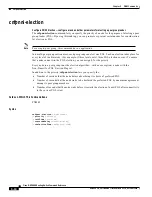
5-18
Cisco MGX 8850 Routing Switch Command Reference
Release 2.0, Part Number 78-10467-04 Rev C0, October 2001
Chapter 5
PNNI Commands
cnfpnni-election
cnfpnni-election
Configure PNNI Election—configure a rank and other parameters for electing a peer group leader.
The cnfpnni-election command lets you specify the priority of a node for the purpose of electing a peer
group leader (PGL). By using this ranking, you can promote or prevent certain nodes for consideration
for election as PGL.
Note
For a single-peer group, this command has no application.
In a multi-peer group environment, each peer group can elect one PGL. Such an election takes place for
every level of the hierarchy. (For example, if three levels exist, three PGL elections occur.) To ensure
that a node cannot win the PGL election, you can assign 0 for the priority.
Every node in a peer group runs the election algorithm—with one exception: a node with the
Non-Transit for PGL E;ection Flag set.
In addition to the priority, cnfpnni-election lets you specify the:
•
Number of seconds that the node delays advertising its choice of preferred PGL
•
Number of seconds that the node waits to be declared the preferred PGL by unanimous agreement
among its peer group members
•
Number of seconds that the node waits before it restarts the election of a new PGL after connectivity
to the current PGL is lost
Cards on Which This Command Runs
PXM45
Syntax
cnfpnni-election <node-index>
[-priority priority]
[-initTime init-time]
[-overrideDelay override-delay]
[-reelectionTime reelection-time]
















































